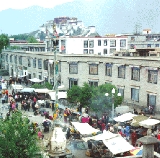
Lhasa Carpet Factory
Encyclopedia
Lhasa Carpet Factory is a factory
south of Yanhe Dong Lu near the Tibet University
in Lhasa
, the capital of the Tibet Autonomous Region
of the People's Republic of China
. It produces traditional Tibetan rug
s that are exported worldwide through Canton
. Although the actual weaving and finishing is done by hand using old-style vertical looms, many of the stages of the process are now mechanised and the dyeing is not done at the factory. It is a modern factory; the largest manufacturer of rugs throughout Tibet
employing some 300 workers. Traditionally Tibetan women were the weavers, men the spinners, but both work on the rugs today.
The factory has developed into the most productive in the Tibet Autonomous Region with an annual output of 30,000 miles of carpet. The rugs manufactured in Lhasa are typically smaller with bold designs and bright colors and a deep even, pile -about 60knots per square inch. Rug weaving
is an ancient craft in Tibet but because it was not for sacred purposes it is not considered an art. As a result there are no rugs verifiable earlier than 1800. Chemical dye
first appeared in Central Asia
around 1870 and is now very widely used. The use of durable cotton warps and wefts was introduced in Lhasa in the early 20th century. The factory is now an important tourist attraction.
Factory
A factory or manufacturing plant is an industrial building where laborers manufacture goods or supervise machines processing one product into another. Most modern factories have large warehouses or warehouse-like facilities that contain heavy equipment used for assembly line production...
south of Yanhe Dong Lu near the Tibet University
Tibet University
Tibet University is the largest university in Tibet, China. It has two campuses: one in Lhasa and one in Nyingchi. About 7500 students are enrolled at the university, and nearly 20% of the students are in the Department of Tibetan Studies, which is a draw for international students as well as locals...
in Lhasa
Lhasa
Lhasa is the administrative capital of the Tibet Autonomous Region in the People's Republic of China and the second most populous city on the Tibetan Plateau, after Xining. At an altitude of , Lhasa is one of the highest cities in the world...
, the capital of the Tibet Autonomous Region
Tibet Autonomous Region
The Tibet Autonomous Region , Tibet or Xizang for short, also called the Xizang Autonomous Region is a province-level autonomous region of the People's Republic of China , created in 1965....
of the People's Republic of China
People's Republic of China
China , officially the People's Republic of China , is the most populous country in the world, with over 1.3 billion citizens. Located in East Asia, the country covers approximately 9.6 million square kilometres...
. It produces traditional Tibetan rug
Tibetan rug
Tibetan rug making is an ancient, traditional craft. Tibetan rugs are traditionally made from Tibetan highland sheep's wool, called changpel. Tibetans use rugs for many purposes ranging from flooring to wall hanging to horse saddles, though the most common use is as a seating carpet...
s that are exported worldwide through Canton
Guangzhou
Guangzhou , known historically as Canton or Kwangchow, is the capital and largest city of the Guangdong province in the People's Republic of China. Located in southern China on the Pearl River, about north-northwest of Hong Kong, Guangzhou is a key national transportation hub and trading port...
. Although the actual weaving and finishing is done by hand using old-style vertical looms, many of the stages of the process are now mechanised and the dyeing is not done at the factory. It is a modern factory; the largest manufacturer of rugs throughout Tibet
Tibet
Tibet is a plateau region in Asia, north-east of the Himalayas. It is the traditional homeland of the Tibetan people as well as some other ethnic groups such as Monpas, Qiang, and Lhobas, and is now also inhabited by considerable numbers of Han and Hui people...
employing some 300 workers. Traditionally Tibetan women were the weavers, men the spinners, but both work on the rugs today.
The factory has developed into the most productive in the Tibet Autonomous Region with an annual output of 30,000 miles of carpet. The rugs manufactured in Lhasa are typically smaller with bold designs and bright colors and a deep even, pile -about 60knots per square inch. Rug weaving
Weaving
Weaving is a method of fabric production in which two distinct sets of yarns or threads are interlaced at right angles to form a fabric or cloth. The other methods are knitting, lace making and felting. The longitudinal threads are called the warp and the lateral threads are the weft or filling...
is an ancient craft in Tibet but because it was not for sacred purposes it is not considered an art. As a result there are no rugs verifiable earlier than 1800. Chemical dye
Dye
A dye is a colored substance that has an affinity to the substrate to which it is being applied. The dye is generally applied in an aqueous solution, and requires a mordant to improve the fastness of the dye on the fiber....
first appeared in Central Asia
Central Asia
Central Asia is a core region of the Asian continent from the Caspian Sea in the west, China in the east, Afghanistan in the south, and Russia in the north...
around 1870 and is now very widely used. The use of durable cotton warps and wefts was introduced in Lhasa in the early 20th century. The factory is now an important tourist attraction.

